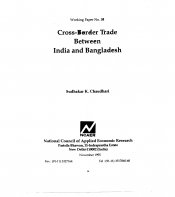Cross border trade between India & Bangladesh
Sudhakar K. Chaudhari
November 1995
Foreign trade plays an important role in the economic development of all nations. While considering foreign trade between closed economics, we often are faced with the phenomenon of illegal international trade. While much effort has been made by economists to track foreign trade related illegal transactions through legal channels via under and over as well as false invoicing, unofficial trade outside official channels has received little attention so far. This study makes an attempt in this direction.
This study looks at the illegal trade flows along the Indo-Bangladesh land border at two levels:
( i ) Cross-border trade outside official channels, and
( ii ) Illegal trade through official channels via false invoicing.
While using the technique of “Partner Country Data Comparisons” for detecting the extent of false invoicing, the study makes a significant contribution in terms of evolving a modified form of the “Delphi” technique for generating primary data through field surveys for assessing the nature and extent of smuggling across the Indo-Bangladesh land border. I am sure that others making a similar effort would benefit from the methodology developed here. “Delphi” is a technique commonly used in corporate research and I believe that this is the first time it is used to develop trade estimates.
The field survey showed some unexpected results. The composition of smuggled goods is dominated by essential commodities and goods of mass consumption. The flow is more or less unidirectional, i.e., from India to Bangladesh. The overall volume as well as the direction of the cross-border trade closely follows the pattern of India’s bilateral trade with Bangladesh, except for the variation in its composition. The survey gives an overall estimate of Rupees 1,165 crores of unofficial exports as against the provisional estimate of Rupees 1,350 crores of official exports during 1993-94. the prices of smuggled goods are generally high across the Bangladesh border, yielding price differentials ranging from 16% to 225% for different commodities.
The study was planned by me and executed under my overall directions by Mr. S.K. Chaudhari, Senior Economist in the council. Mr. Chaudhari devised a semistructured format for data collection and organized the field work. The data was analysed and the report was prepared by Mr. Chaudhari under my close supervision. Dr. A.K. Roy and his senior associates in “Economic Information Technology”, Calcutta, did the field work.
I would like to place on record an appreciation of the response and cooperation extended by the central and state government officials, respondents from the law enforcement agencies, trader and carrier groups, and others. Without this cooperation the study would not have been possible.
National Growth and Macroeconomic Centre







